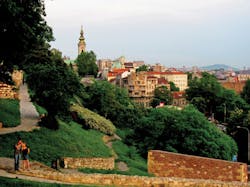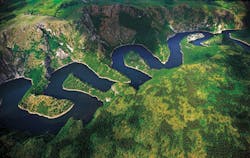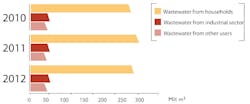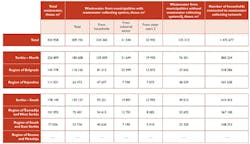| Only 8% of all available surface waters in the Republic of Serbia originate within its borders. The remaining 92% are transboundary waters entering Serbia through the Danube, Sava, Tisa, Drina and other rivers |
The average specific water consumption per capita in Serbia is about 350 l/day of raw water for drinking purposes, sourced from groundwater (59%), surface water (24%) and springs (17%). Approximately half of the country's population lives in urban areas and is supplied by the three largest (Belgrade, Novi Sad and Niš) or medium-sized water supply systems.
In the Autonomous Province of Vojvodina there are 465 settlements of which 69 do not have piped water. People living in rural areas get their drinking water from three different sources: i) official piped water systems owned and operated by the municipality; ii) private piped systems built and operated by the communities themselves, and iii) private wells (tube well/borehole with pump, dug well.
Data on rural public water supply systems are very scarce, but it is estimated that there are about 5,000 that are not registered and are not water quality controlled.
Water supply systems cover 300,000 private wells. Only 10% of the exploited water sources are protected with sanitary protection zones around intakes.
Wastewater in Serbia
In most European cities the percentage of households connected to the sewerage system varies around 95% while in Belgrade this number reaches only 85%. At the national level these indicators show an even worse situation. For example in the Province of Vojvodina the same indicator is around 45%, while in central Serbia it goes even lower with around 37% of the population is connected to the sewerage system.
The results of an analysis performed within the project 'Global Waste Water Study in Serbia & Pre-feasibility Study for Belgrade Waste Water Management' show that about 75% of the total urban population in Serbia is connected to the public sewerage system.
The percentage of the rural population connected the public sewerage system is about 9%. Only three urban municipalities have a rate higher of 75% - Kragujevac, Novi Sad and Sremski Karlovci.
Agglomerations with a population smaller then 25,000 are usually equipped with the general sewerage system while municipalities with 25,000 to 250,000 citizens have a separate stormwater system. The city of Novi Sad has only one sewerage system.
Abandoned WWTPs
A survey shows that there are 19 municipalities in Serbia, with wastewater treatment plants, 14 with biological treatment and five with mechanical treatment.
Concerning the rest of Serbia, only seven local municipalities have already started to build such a plant (six with biological treatment) while 11 municipalities reported that they are planning the construction in the near future.







